Powell Library (UCLA)
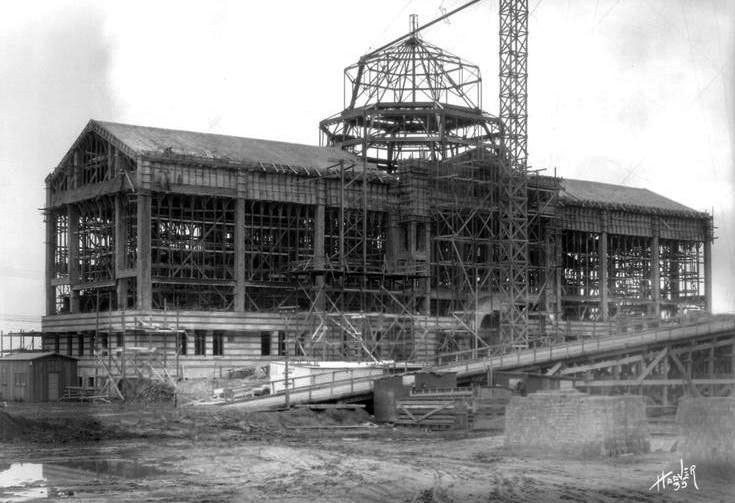 |
|
| (1928)^ - View showing the early stages of construction of Powell Library, showing the steel beems of its central tower. The building is surrounded by and filled-in with scaffolding. Originally known simply as the Library, Powell Library was known as College Library prior to 1966. |
Historical Notes It was constructed from 1926 to 1929 and was one of the original four buildings that comprised the UCLA campus in the early period of the university's life. Its Romanesque Revival architecture design, its historic value and its popularity with students make it one of the defining images of UCLA. |
.jpg) |
|
| (1929)* - Exterior view of the library, now Powell Library, under construction at the U.C.L.A. Westwood campus in 1929. This building was built 1927-29 and designed by architect George W. Kelham. |
Historical Notes Powell Library is one of the original two buildings erected at the Westwood Campus in 1929 (the other being Royce Hall). Architects George W. Kelham and David Allison drew on Italian churches for their inspriation in designing the library. |
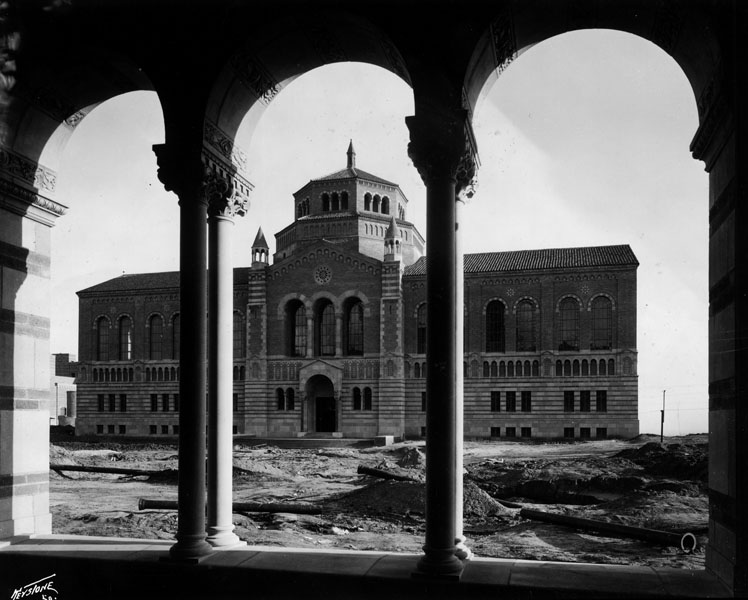 |
|
| (1929)* - Construction of the new U.C.L.A. Westwood campus in 1929. View is looking from Royce Hall's construction site, towards the nearly completed of Powell Library. |
Historical Notes Both Powell and Royce follow the Lombardian type of Italian Romanesque architecture, with bits of Byzantium thrown into the mix. Moorish elements were added to reflect California's Spanish culture |
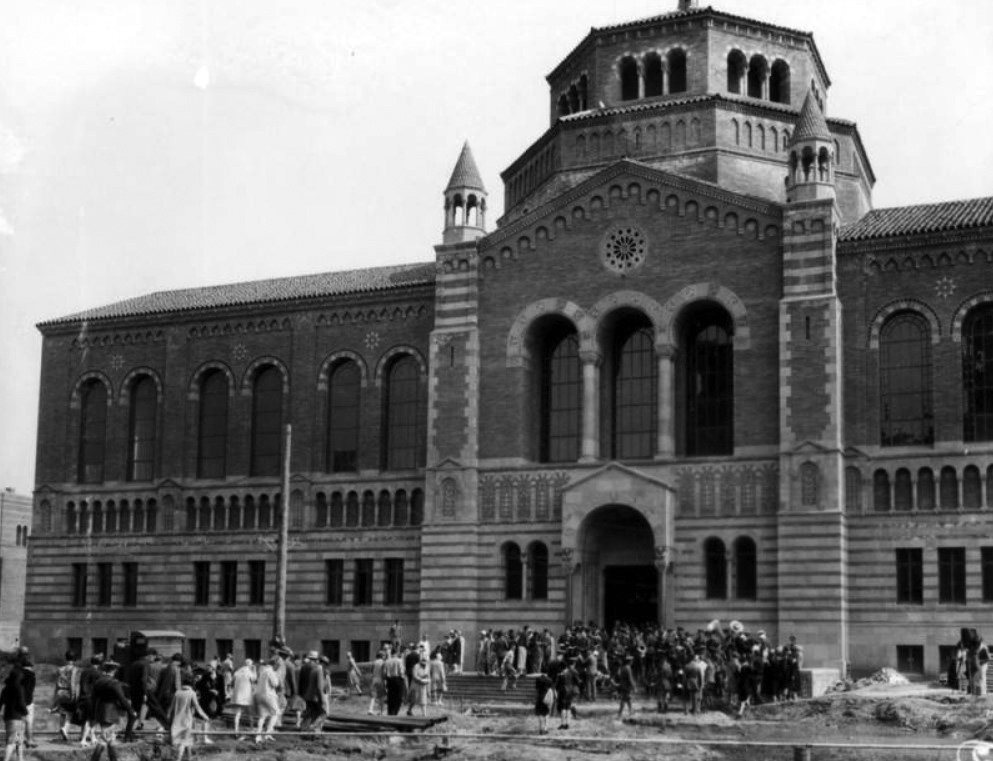 |
|
| (1929)* - Students are seen walking to and from the library, amid the construction activity. Building was built 1927-1928 in a northern Italian Romanesque Revival style, designed by architect George W. Kelham. |
Historical Notes Architect: George W. Kelham was a San Francisco architect, who arrived in the city soon after the earthquake of 1906. Previous to his career in California, Kelham had studied at Harvard and then at Rome and Paris, and beginning in 1899 practiced architecture in New York. He was the Chief ofthe Architectural Department for San Francisco's 1915 PanamaPacific Exposition, and has several San Francisco commercial buildings to his credit: American National Bank Building, Standard Oil Building, Shell Oil Building, the Russ Building, San Francisco Public Library, and the Federal Reserve Bank. He also designed the Los Angeles Standard Oil Company Office Building (1923-24), which is similar to the earlier San Francisco structure. He was commissioned to design a master plan for the University of California, Berkeley, campus in 1925, and became the campus architect two years later. As UCLA was at first the southern branch of the university at Berkeley, Kelham developed the master plan for the new campus as well.* |
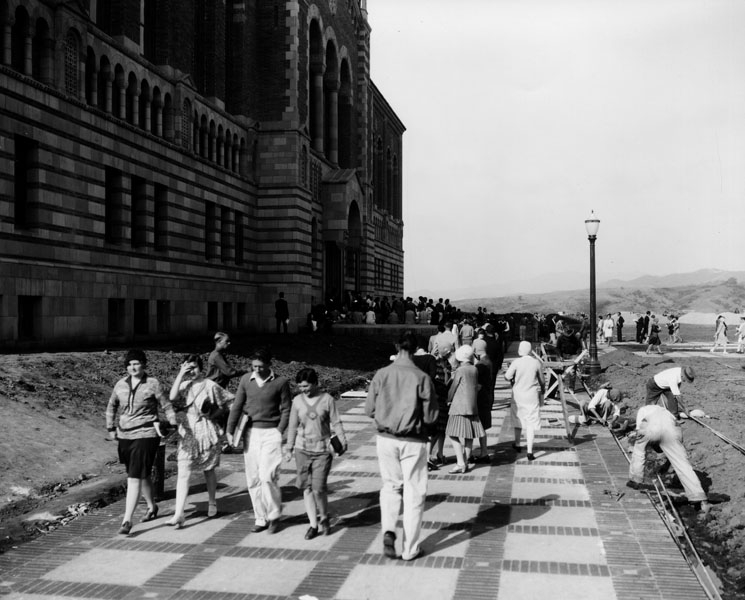 |
|
| (1929)* - View looking west showing both students and construction workers in front of the Powell Library on Opening Day. |
Historical Notes Opening Day on the new UCLA Westwood campus was on September 20, 1929. Construction activity continued while classes began. |
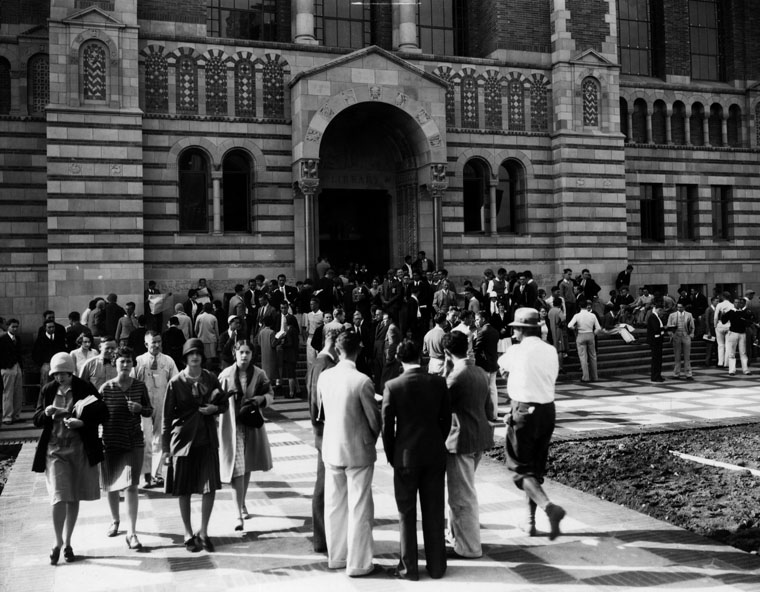 |
|
| (1929)* - Opening Day at the new UCLA campus. Students are dressed in the latest styles as they congregate in front of the Powell Library.. |
Historical Notes Opening Day on the new UCLA Westwood campus was on September 20, 1929. Construction activity continued while classes began. |
 |
|
| (1928)^.^ – View of Powell Library from Royce Hall. Both buildings were adapted from the Italian Romanesque architecture of the churches of Piassa Santo Stefano in Bologna, Italy. Photo by Adelbert Bartlett. |
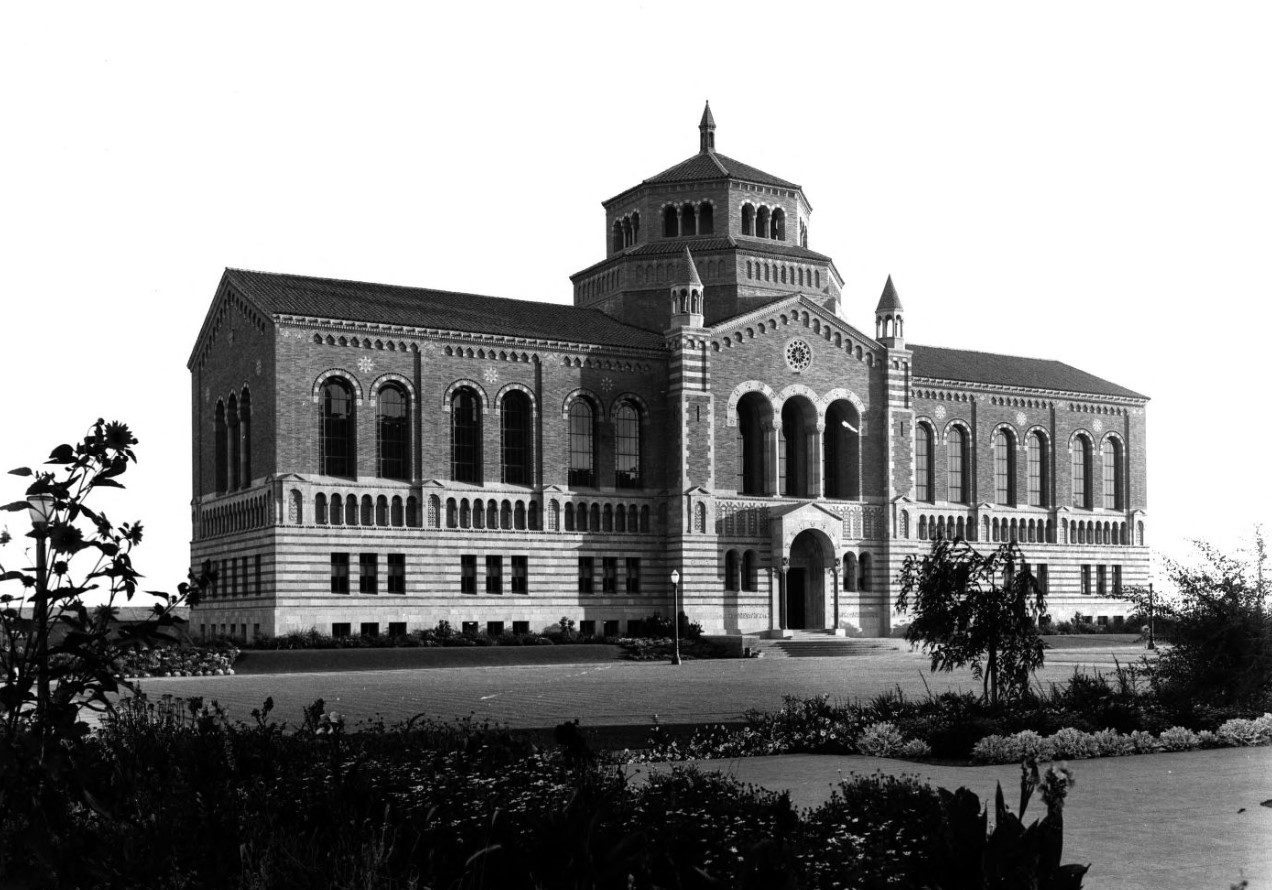 |
|
| (ca. 1930)^ - The north side of the Library (subsequently known as College Library and, after 1966, the Lawrence Clark Powell Library) is photographed here from the foot of the Chemistry Building (Haines Hall). By the close of the first academic year on the Westwood Campus, landscaping around all of the Esplanade buildings had been completed. |
Historical Notes Both Powell Library and Royce Hall were constructed in an adaptation of the Lombardian type of Italian Romanesque architecture, and their designs also embody many aspects of the Byzantine. In addition, because of the extensive Spanish influence in the history of Southern California, appropriate Moorish touches were added to the basic design. The Library's Lombard porch with its single-arched doorway closely resembles the church of San Zenove in Verona, although some maintain it was adapted from the rear of the basilica of San Ambrogio in Milan, the front of which inspired the design of Royce Hall. Carved into the lintel above the human-figured capitals of the porch arc two supporting Atlantes, straining under a great load. Such dwarfish figures, along with the leaf-scroll designs found on the moldings of the rounded arch of the portal, have many counterparts in Lomba rd churches. The spandrel above the front entrance feature the Owl of Wisdom, with the God of Light on one side and the God of Learning on the other.* |
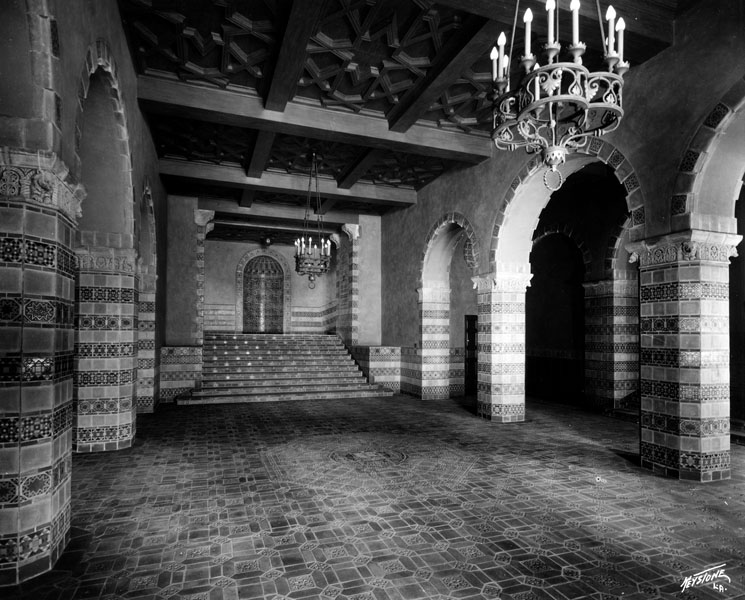 |
|
| (1930)* - Interior view of the Library Building at the new UCLA campus showing detailed mosaic tile and brick work. |
Historical Notes If mosaic is defined as pictures or designs made by setting small colored pieces of stone, glass, or tile onto a surface, then these pillars at the Powell Library of UCLA certainly qualify as mosaics. In fact, there are so many of these ornamentally tiled features--columns, alcoves, niches, steps--in the library, it's downright distracting. Who could study? |
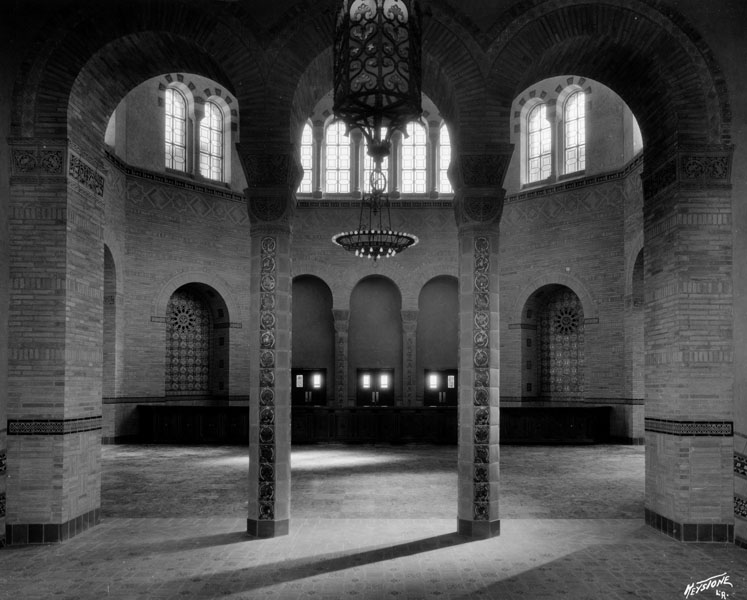 |
|
| (1930)* - Interior view of the rotunda at Powell Library, at UCLA Building was built 1927-29 in a Italian (Lombard) Romanesque Revival style. |
Historical Notes The great amount of skilled hand work needed for the detailed tile and brick work of the Lombard style of architecture made it impossible to continue in the same architectural tradition when costs rose after World War II. The above view shows the interior of the main lobby and stairs to the reading room at the Powell Library.* |
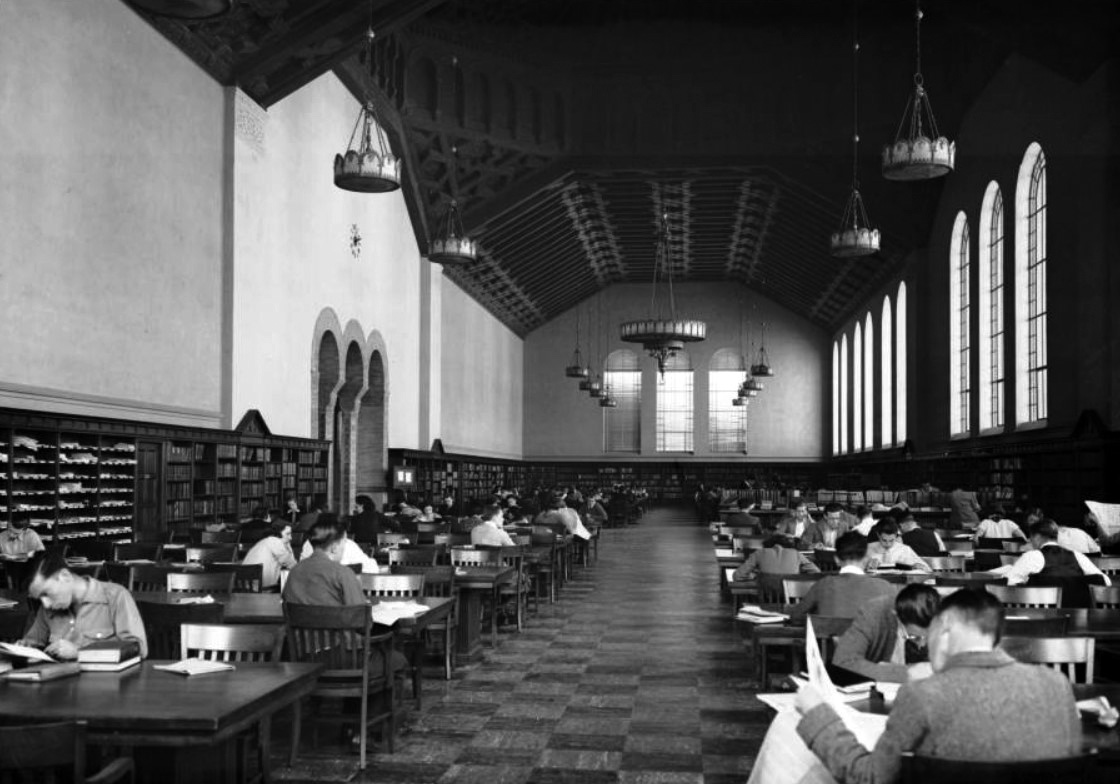 |
|
| (ca. 1930s)^^ - Main reading room at the Lawrence Clark Powell Library showing high arched ceilings and massive windows. The floor is covered with marble tiles. |
Historical Notes The dramatically scaled Main Reading Room is 212 feet long and 56 feet wide. Its octagonal central dome, which stand 63 feet from the floor, is ornamented by the marks, or colophons, of forty printers of the fifteenth and sixteenth centuries, including such noteworthy figures as William Caxton, Aldus Pius Manutius, and Walter Chepman. |
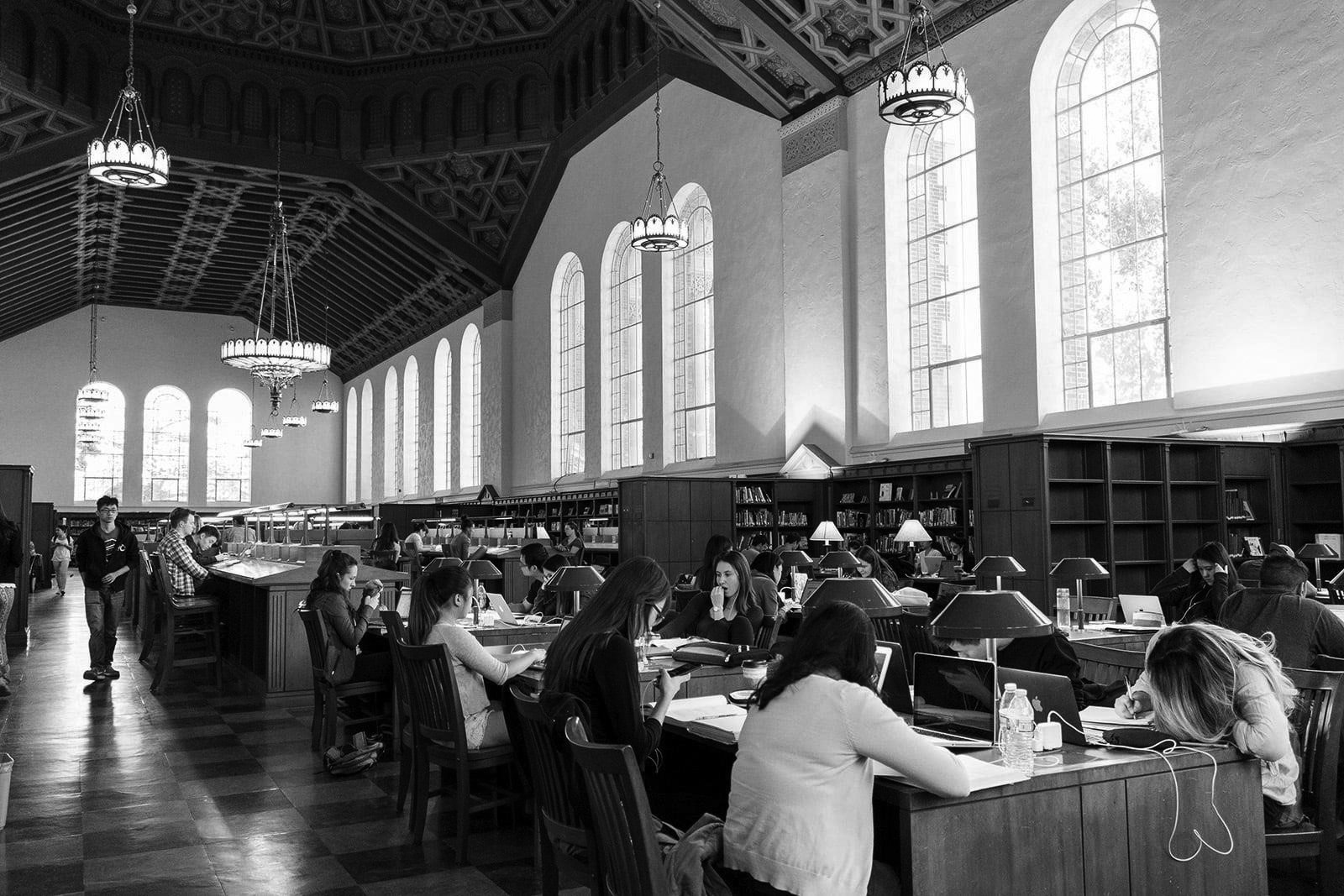 |
|
| (2018)^.^ – Powell Library Reading Room. Not much has changed except for the computers and cell phones. |
Historical Notes Students at UCLA have affectionately called this library "Club Powell" because it has a reputation for being louder than most libraries. Others explain that it is because this library has a room called Night Powell that is open 24/7 beginning on third week. |
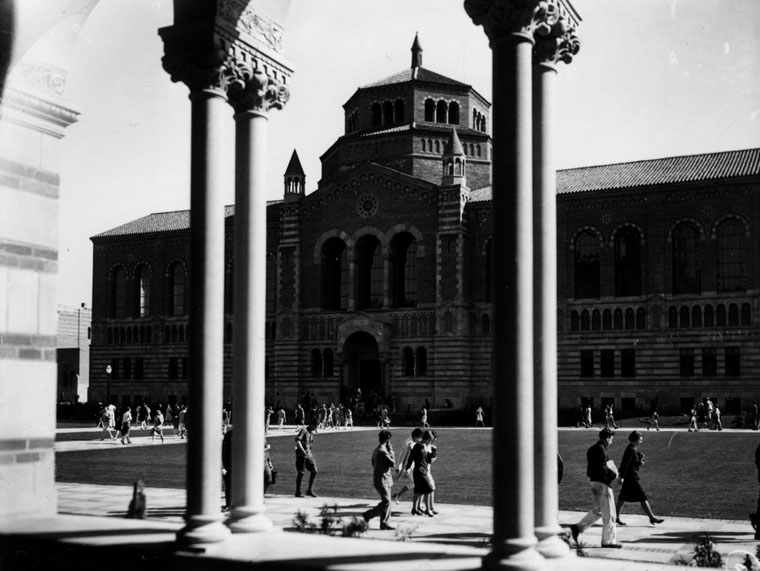 |
|
| (1929)*- Powell Library as seen through the arches of Royce Hall. |
Historical Notes The Library and Royce Hall were the first two buildings on the Westwood campus. The rolling hills, the then-blue sky and clean air, the proximity to the ocean - all suggested northern Italy to the architects, George W. Kelham and David Allison, and they looked to churches in Verona, Bologna, and Milan for their models and their inspiration. |
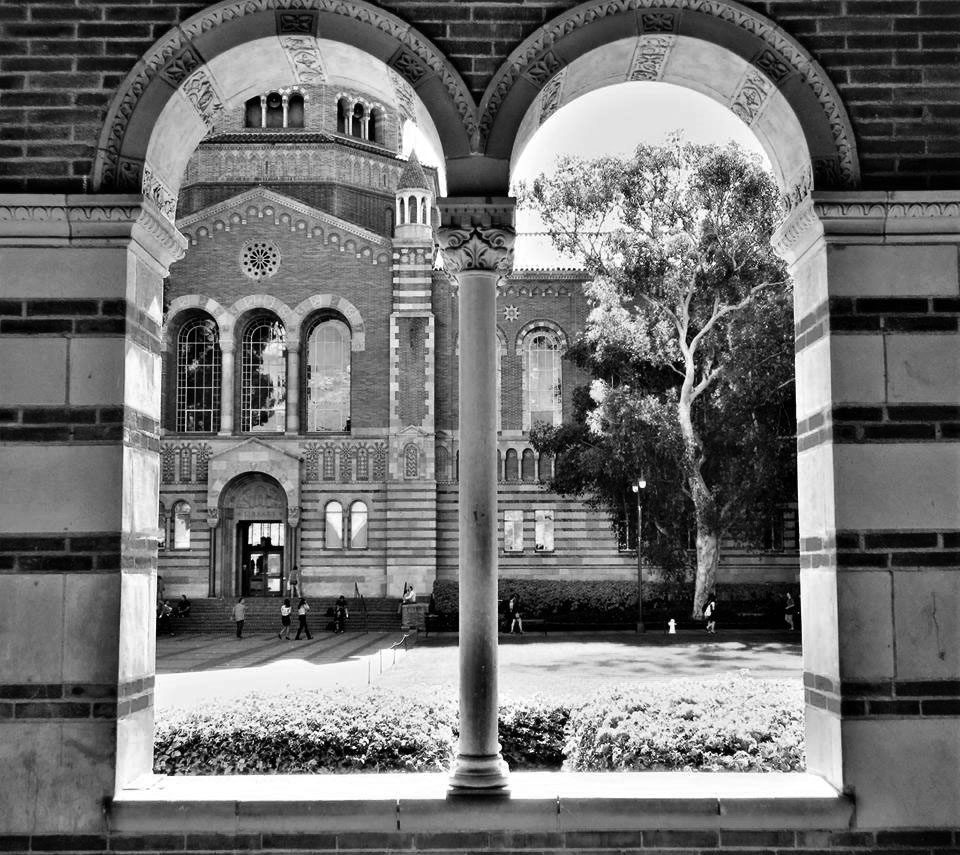 |
|
| (2018)^.^ - Contemporary view showing Powell Library as seen through the Royce Hall arches. Photo by Howard Gray |
Historical Notes Little Known Fact: In 1951, author Ray Bradbury wrote an early draft of his classic novel Fahrenheit 451 in Powell Library using typewriters that were then available for rent. |
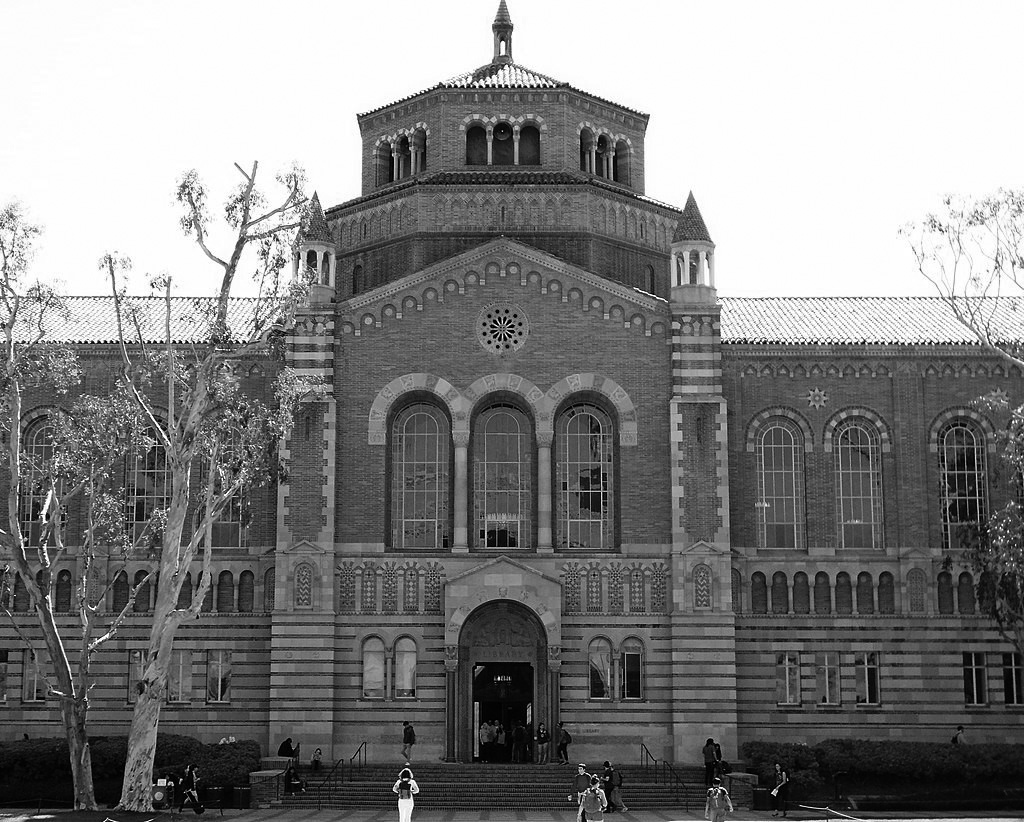 |
|
| (2019)^ – Front view of the Powell Library, located on Dickson Court. |
Historical Notes Powell hosts de-stressor programs during tenth and finals week, which include bringing therapy dogs, origami stations, and meditation. Located in the second floor Rotunda, this UCLA library often hosts events. Past events include the Edible Book Festival, Silent Disco, Video Game Orchestra, and International Games Day. |
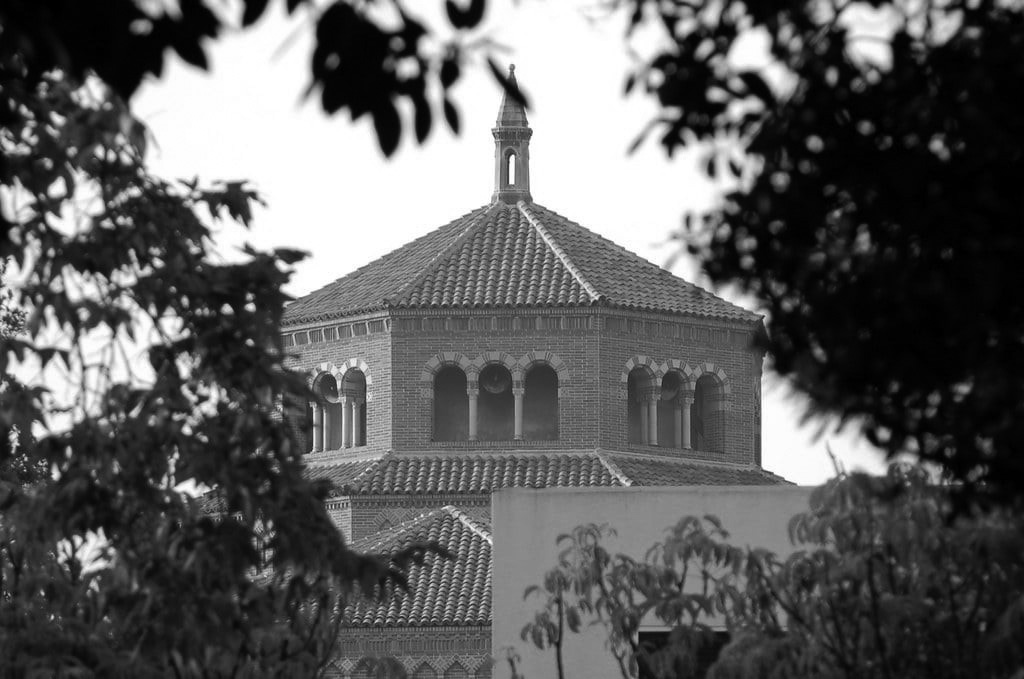 |
|
| (2018)^.^ - Telephoto view showing the Powell Library rotunda with its arched balconies.. |
Historical Notes Bells have been integral to the UCLA campus since 1939 when they first rang out from the East Tower of Royce Hall. They were a gift from Countess Harriet and Count Frederick Thorne-Rider. In 1945, Frank and Alger Soule wrote and published the song "Chimes of Westwood." The song tells the story of lovers parting and hoping to reunite in Westwood - the bells will ring to bring them back together. The cover for the sheet music features Jeanne A'Dair, then the carillonneur at UCLA. In 1955 an electronic carillon was installed in Powell, with the controls installed in Schoenberg Music Building in 1956. Previous carillonneurs at UCLA include Jeanne A'Dair, Laura Brown, Mary Crawford, and Peggy Sheffield. The UCLA carillon was used for "Weird Al" Yankovic's song "Christmas at Ground Zero" on the 1986 album Polka Party!.* |
Then and Now
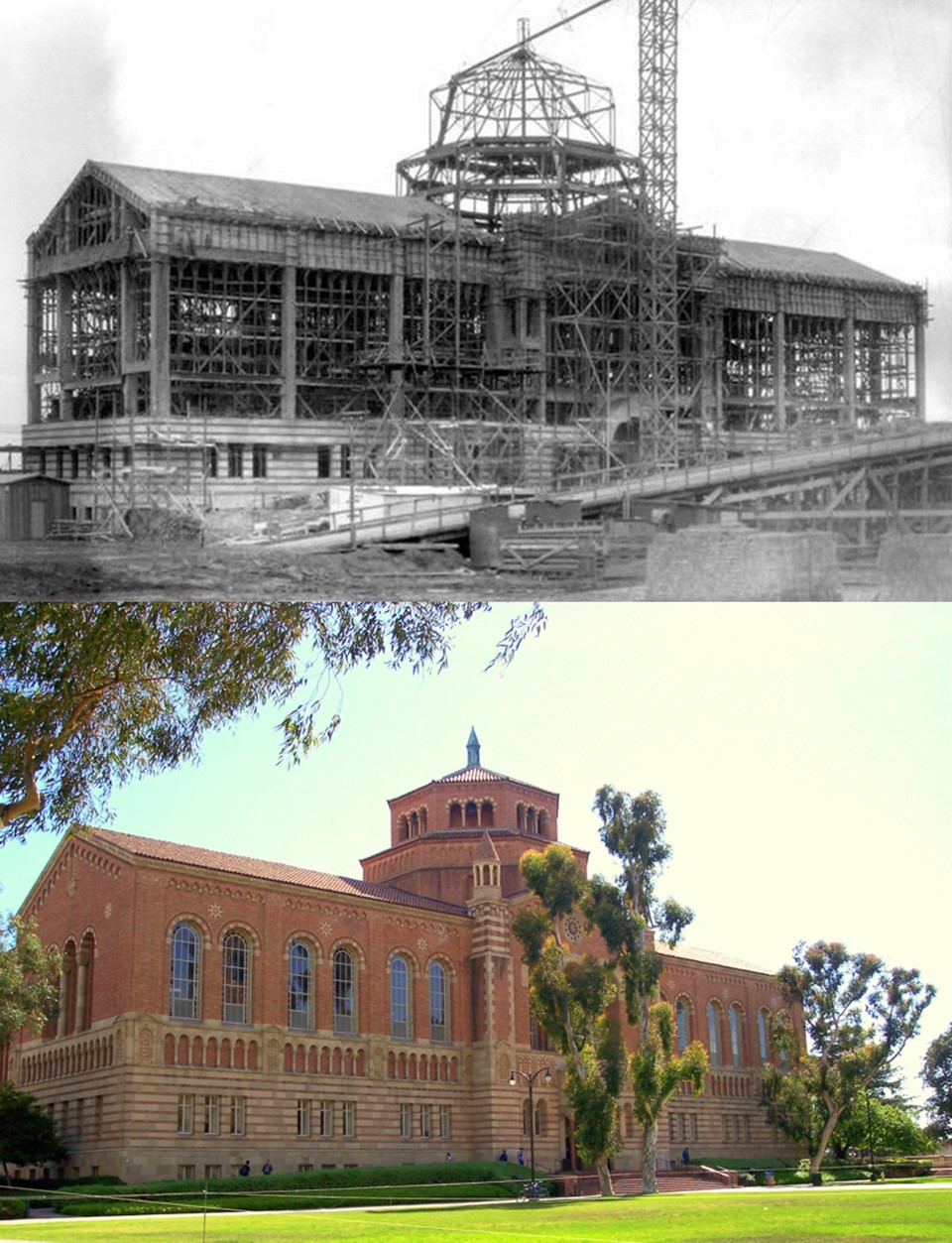 |
|
| Then and Now - The 1929-built Powell Library* |
Click HERE to see History of UCLA and more Early Views. |
* * * * * |
|
Other Sections of Interest |
|
Water and Power in Early LA |
|
Newest Additions |
New Search Index |

A new SEARCH INDEX has been added to help navigate through the thousands of topics and images found in our collection. Try it out for a test run.
Click HERE for Search Index |
* * * * * |
< Back
Menu
- Home
- Mission
- Museum
- Major Efforts
- Recent Newsletters
- Historical Op Ed Pieces
- Board Officers and Directors
- Mulholland/McCarthy Service Awards
- Positions on Owens Valley and the City of Los Angeles Issues
- Legislative Positions on
Water Issues
- Legislative Positions on
Energy Issues
- Membership
- Contact Us
- Search Index
© Copyright Water and Power Associates
Layout by Rocket Website Templates